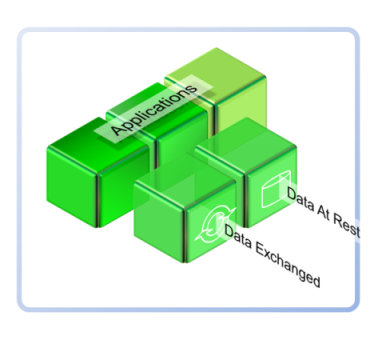Information Architecture
An effective information architecture comes from understanding business objectives and constraints, the content, and the requirements of the people who will use the services.
It is essential to understand how information is handled within an enterprise to serve its business objectives, as should be captured in a Business Architecture description.
Systems architectures will be shaped by the requirements for:
- Information exchange
- Information access
- Information format
- Information manipulation
- Information storage
- Information protection
For taxonomical purposes, an Information Architecture can be structured as:
- Applications architecture. The structure and behaviour of applications used in aorganisation, focused on how they interact with each other and with business users. The applications architecture is shaped by where data is obtained from and where it is used. The applications are usually mapped to the business functions they support and the platform technologies they need.
- Data architecture. The definition, storage and movement of structured data:
- Data At Rest
- Data Exchanged
Applications
Key characteristics: A program or group of programs designed for end users. Application software can be divided into two general classes:
- Systems software consists of low-level programs that interact with the computer at a very basic level. This includes operating systems, compilers, and utilities for managing computer resources.
- Applications software includes database programs, word processors, and spreadsheets. Figuratively speaking, applications software sits on top of systems software because it is unable to run without the operating system and system utilities.
A data architecture describes the data structures used by a business and/or its applications. There are descriptions of data in storage and data exchanged; descriptions of data stores, data groups and data items; and mappings of those data artifacts to data qualities, applications, locations etc.
Essential to realising the target state, Information (Data) Architecture describes how data will need to be processed, stored, and utilised in a given system. It provides criteria for data processing operations that make it possible to design data flows and also control the flow of data in the system.
The EA applies a broad definition to the term 'Applications' to encompass all potential scenarios. An Application can be specific COTS or specialised software or a broad definition such as IP telephony, depending upon each specific context. A bandwidth-hungry application such as imagery, or latency sensitive application such as voice or videoconferencing have obvious implications for the Infrastructure architecture.
Data Exchanged
Key characteristics:Also called Data In Transit. The Applications deployed, or to be deployed, determine the data that will be exchanged. The data to be exchanged will determine the standards and interfaces required between data domains and data users.
Data Exchanged is commonly delineated into two primary categories - data that is moving across public or untrusted networks such as the Internet, and data that is moving within the confines of private networks such as corporate Local Area Networks. A related concept is Data In Use, which refers to data that is being processed.
- Interfaces. The hardware and software requirements for transmitting data between end points in a data exchange are a part of the Systems Architecture.
At the Information Architecture level, the interfaces are described in terms of the information format at the source, and the format required at its
destination - such as human-readable vs machine readable, text vs speech etc.
The information interface descriptions consider the users' requirements, whether they are human or machine, fixed, location independent or mobile. Information Architect's will take these aspects to a far greater level of granularity than that needed for a Network Architecture.
- Standards. From a Network Architect's perspective, the standards to be considered will be derived from the nature of the applications and how they are used - bandwidth requirements, latency, legacy protocols, prioritisation and availability requirements are some examples of the nature of the informtion exchange that will be required to devise the next level Systems and Infrastructure architectures.
Data At Rest
Key characteristics: Can be archival or reference files that are changed rarely or never.
Data At Rest can also be data that is subject to regular but not constant change. Examples include corporate files stored on the hard drive of a user's computer, files on an external backup medium, files on the servers of a storage area network, or files on the servers of an offsite backup service provider.
The nature of the Data At Rest, where it is stored, who needs to access it and how it needs to be protected are critical considerations for a network architecture - determining the optimal design options at the Systems and Infrastructure levels.




